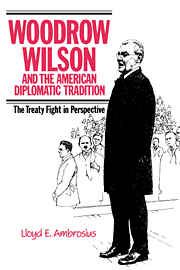Book contents
- Frontmatter
- Contents
- Preface
- Acknowledgments
- List of abbreviations
- 1 Introduction: Wilson's new world
- 2 Origins of Wilson's league of nations idea
- 3 Drafting of the League of Nations Covenant
- 4 American criticism of Wilson's peacemaking
- 5 Revision of the League of Nations Covenant
- 6 The question of control at home and abroad
- 7 The Versailles Treaty in the Senate
- 8 American rejection of the Versailles peace
- 9 The aftermath of Wilson's peacemaking
- 10 Epilogue: Wilson's legacy
- Bibliography
- Index
6 - The question of control at home and abroad
Published online by Cambridge University Press: 18 September 2009
- Frontmatter
- Contents
- Preface
- Acknowledgments
- List of abbreviations
- 1 Introduction: Wilson's new world
- 2 Origins of Wilson's league of nations idea
- 3 Drafting of the League of Nations Covenant
- 4 American criticism of Wilson's peacemaking
- 5 Revision of the League of Nations Covenant
- 6 The question of control at home and abroad
- 7 The Versailles Treaty in the Senate
- 8 American rejection of the Versailles peace
- 9 The aftermath of Wilson's peacemaking
- 10 Epilogue: Wilson's legacy
- Bibliography
- Index
Summary
Once Germany signed the Versailles Treaty, Wilson returned to the United States to urge the Senate to approve it. Continuing his politics of confrontation, he chose to fight rather than conciliate critics of his peacemaking. He wanted to defeat his opponents, not compromise with them. The question of control divided Americans in two different ways during the treaty fight. The president believed that the League of Nations would enable the United States to exercise its benevolent influence over other countries. While controlling foreign affairs, the American government could still avoid entanglement in the Old World's politics and wars. The League would inaugurate a “new order” of international relations to replace the old system of alliances and balances of power. Wilson's critics, in contrast, saw in the League a threat to American independence. Not only would it entangle the United States in perpetual conflict around the globe, it would also allow foreign powers to meddle in this country's domestic affairs and violate the Monroe Doctrine. It would subject the nation to foreign control. This question of control constituted the central issue in the treaty fight. Advocates and critics disagreed basically over the question of whether the League would enable the United States to control the world, or the world to control the United States. This dispute related to another controversy over decision-making. Wilson viewed the conduct of American foreign relations as primarily a presidential function, but Lodge and his Republican colleagues asserted the rights of Congress.
- Type
- Chapter
- Information
- Woodrow Wilson and the American Diplomatic TraditionThe Treaty Fight in Perspective, pp. 136 - 171Publisher: Cambridge University PressPrint publication year: 1987



